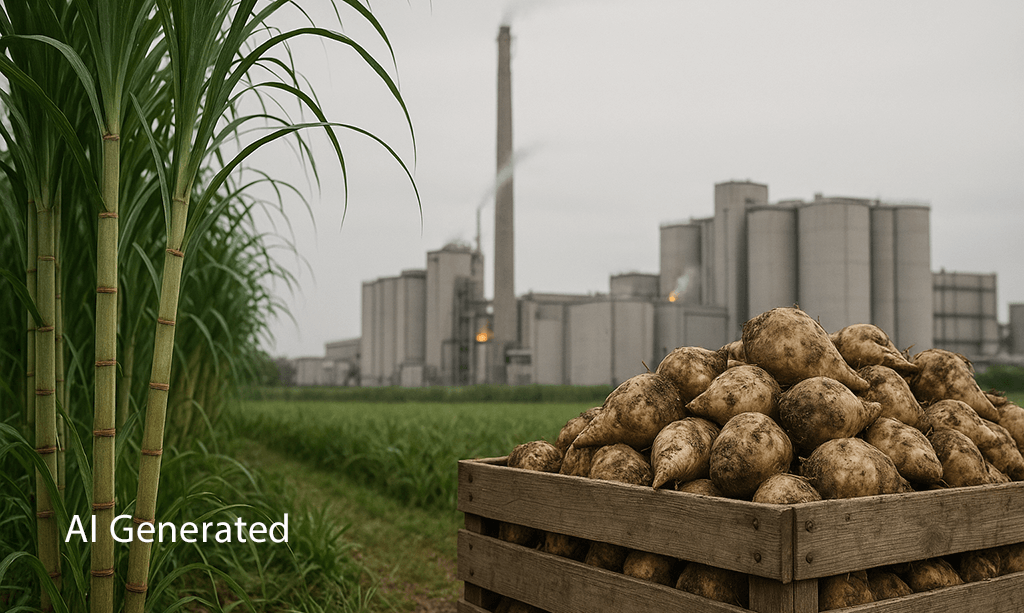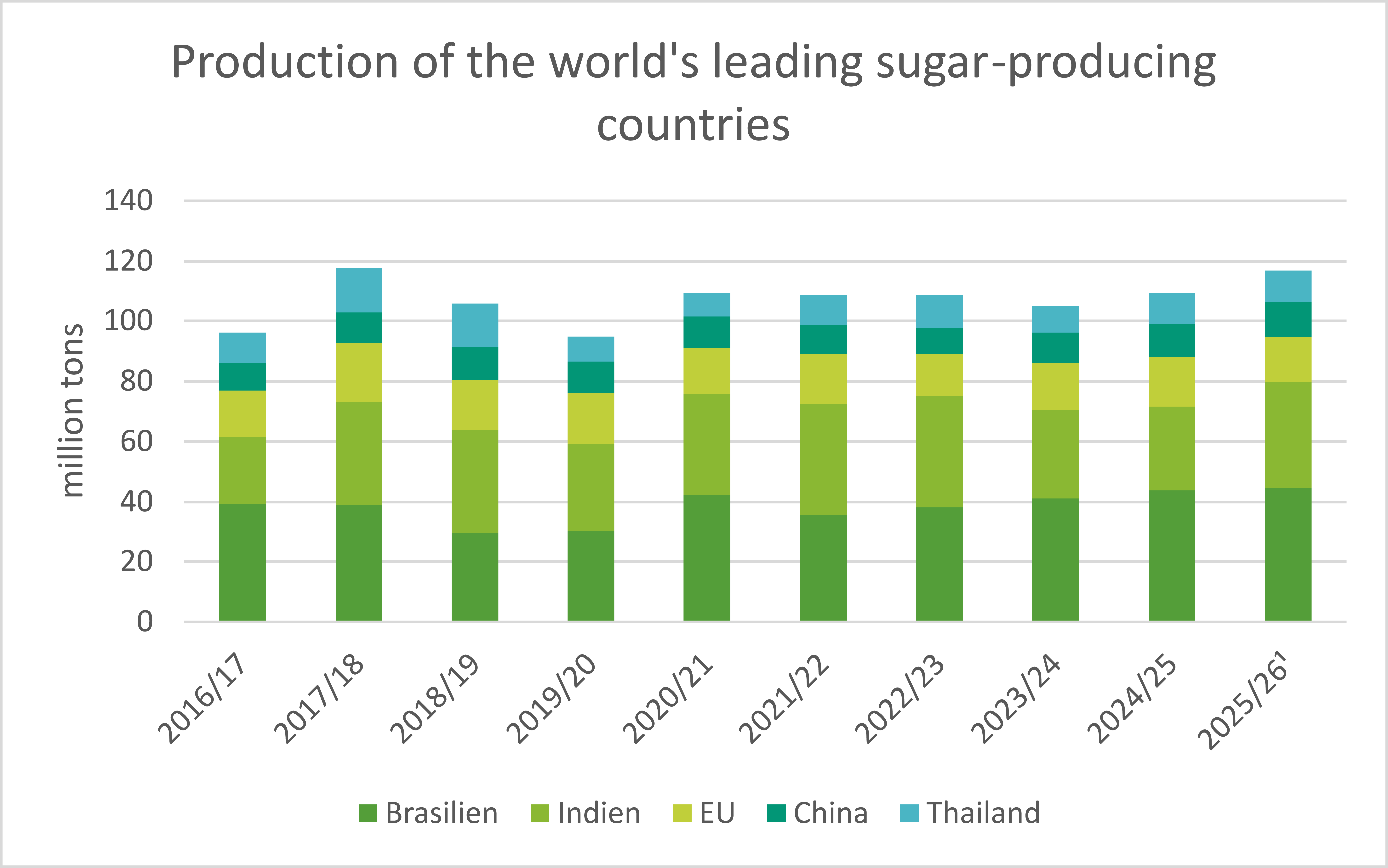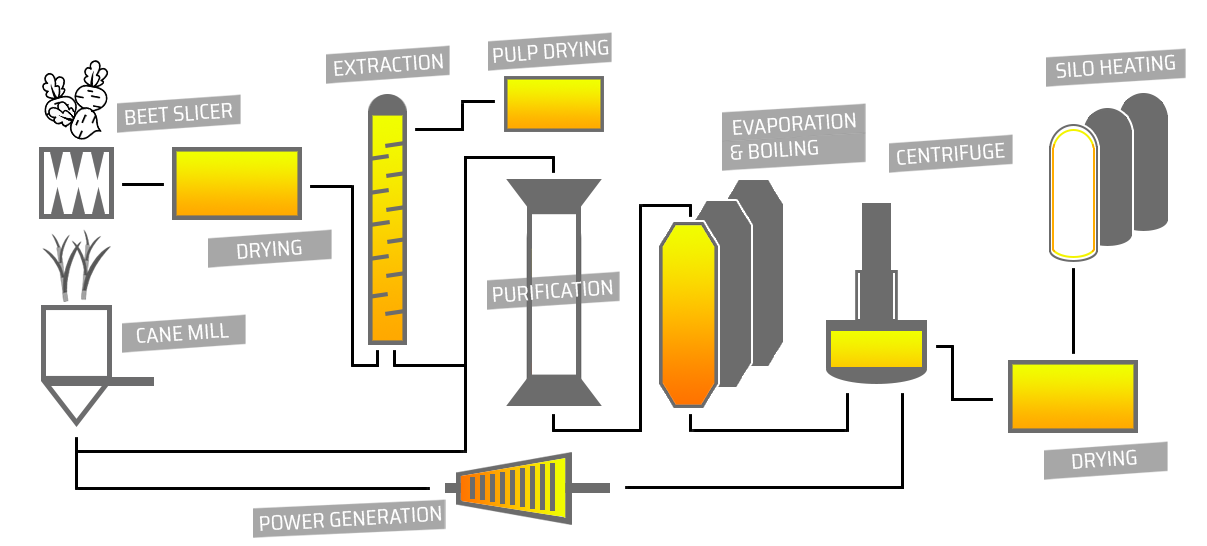Using Renewable Energy and Thermal Batteries in the Sugar industry

Sugar plays an important role in the modern food industry. In Europe, it is mainly produced from beets, while in South America and Southeast Asia, it is mainly produced from sugar cane. The industrial processing of these plants is energy-intensive. In 2020, the sugar industry was the second-largest European energy consumer in the food sector. The associated emissions are mainly caused by the use of fossil fuels for process heat during processing. However, they can also be reduced easily and economically by using Kraftblock’s thermal storage for electrification with renewable energy.
Process heat in the Sugar Industry
We encounter sugar every day – in coffee, baked goods, or canned foods. It is not only a luxury food, but also a key ingredient in numerous industrial products. Global per capita consumption averaged 25.5 kg in 2022, and in Germany it was as high as 50.1 kg per person.¹ In 2023, over 2.3 billion tons of sugar cane and 280 million tons of sugar beets were harvested worldwide. Total global sugar production in 2024 amounted to around 180 million tons.²

While sugar cane is mainly grown in tropical regions such as Brazil, sugar beets come primarily from temperate climates such as Europe. Both raw materials undergo similar basic processes: extraction of sugar juice, purification, evaporation, crystallization, and drying. However, the energy requirements differ - and heat requirements in particular are key to reducing CO₂ emissions.3

Energy-intensive thermal process in the sugar industry
The production of sugar from sugar beets requires between 1,200 and 2,100 kWh of energy per ton of raw sugar, while for sugar cane the figure is around 3,000 kWh per ton.5,6 In the EU, the energy requirement for sugar production amounts to around 18 to 35 TWh per year, depending on the specific consumption used as a basis.7 The differences arise mainly from whether energy-intensive processes such as drying or lime production are included in the calculation. While sugar cane operations are largely energy self-sufficient in many cases thanks to the combustion of bagasse - the fibrous residue left over after pressing - sugar beet factories still cover most of their heating requirements with fossil fuels such as natural gas.8,9
A look at the process chain9 shows:
- Evaporation: Removing water from the sugar juice is the most energy-intensive step. Steam at temperatures of up to 135 °C is used in several evaporation stages.
- Lime burning: Lime is needed to purify the sugar juice. It is obtained from limestone at temperatures between 830 and 1,200 °C – a highly temperature-intensive step.
- Drying beet pulp: The by-products are dried in rotating drum dryers at temperatures ranging from 500 °C to over 900 °C.
Central steam networks are the source of heat supply for many other steps. At low temperatures below 100 °C, this is the case for extraction, purification, and crystallization. Filtration can even take place at higher temperatures. Fossil fuel sources for steam generation can easily be electrified. Large steam networks operate at higher temperatures than the actual process temperature, which often makes heat pumps a questionable solution. In order to still be able to electrify cost-effectively, flexibility is needed to purchase electricity only at favorable times. Thermal storage systems from Kraftblock are the solution for shifting electricity as heat (power-to-heat) from cheap to expensive times.
Lime and milk of lime: energy-intensive key process in juice purification
In juice purification (liming), limestone is first calcined in a lime kiln at around 830–1,200 °C to produce quicklime (CaO).9 This process emits CO₂ on its own on top of the emissions from fossil fuels. The quicklime is then slaked with water to produce milk of lime, which is added to the raw juice, binds non-sugars and prepares for carbonation. The addition of CO₂ – usually from the kiln exhaust gas – causes calcium carbonate (CaCO₃) to precipitate, which binds impurities and is then filtered out. The resulting filter cake (Carbokalk) is pressed and often used as fertiliser. The filtrate is the thin juice (≈ 16 % sucrose), which is then thickened and crystallised. The waste heat from a lime kiln can also be used with the Kraftblock storage system.
Thermal Batteries as enabler of the transition for Sugar Industries
Kraftblock's thermal storage system enables electricity from renewable energies to be stored in the form of high-temperature heat and made available as needed. This allows fossil fuels to be replaced, production peaks to be cushioned, and process stability to be increased at the same time. Kraftblock uses power-to-heat technology, a resistance heater. In contrast to electrode boilers, electricity can be converted into process heat at the best possible time and then stored for later use or around the clock. The differences this makes are explained in the white paper about flexibilisation of electricity as heat.
The sugar industry faces a double challenge: it must remain competitive while significantly reducing its carbon footprint. Heat demand offers the greatest leverage potential — and high-temperature storage is a key technology for making the sugar industry's energy supply climate-neutral, cost-effective, and resilient.
Sources
1) Federal Statistical Office (2022): Per capita sugar consumption in 2022. Online: https://www.destatis.de/DE/Themen/Laender-Regionen/Internationales/Thema/bevoelkerung-arbeit-soziales/gesundheit/Zucker.html?
2) USDA (2025: Sugar: World Markets and Trade Online: https://apps.fas.usda.gov/psdonline/circulars/Sugar.pdf
3) ScienceDirect (2022): Performance analysis and electricity potential for Nzoia sugar factory. Online: https://doi.org/10.1016/j.egyr.2022.10.432
4) Enerdry (2015): Energy and the environment in beet sugar production. Online: https://enerdry.eu/wp-content/uploads/2015/12/jensen-AS-ESST-reprint.pdf
5) ESST (2015): Energy and the environment in beet sugar production. Online: https://enerdry.eu/wp-content/uploads/2015/12/jensen-AS-ESST-reprint.pdf
6) UNIDO (2025): Unleashing the Power of the Sugar Industry. Online: https://www.unido.org/sites/default/files/unido-publications/2025-07/Unleashing%20the%20Power%20of%20the%20Sugar%20Industry%20Report.pdf?
7) FoodDrinkEurope (2021): Decarbonisation road map for the European food and drink manufacturing sector. Online: https://www.fooddrinkeurope.eu/wp-content/uploads/2021/09/Decarbonising-the-European-food-and-drink-manufacturing-sector_v2.pdf
8) The Brazilian Report (2021): Ethanol Producers Use Sugarcane Byproducts to Generate Electricity. Online: https://www.wilsoncenter.org/blog-post/ethanol-producers-use-sugarcane-byproducts-generate-electricity?
9) PBL (2019): Decarbonisation options for the Dutch sugar industry. Online: https://www.pbl.nl/uploads/default/downloads/pbl-2019-decarbonisation-options-for-the-dutch-sugar-industry_3481.pdf
